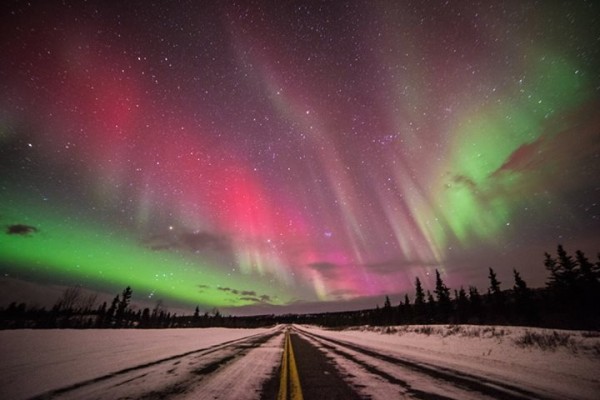Why do Auroras Have Different Brilliant Colors? It's All About Powerful Solar Storms
| Ana Verayo | | Mar 19, 2015 08:38 AM EDT |
(Photo : Sebastian Saarloos/NASA Goddard) "St. Patrick's Auroras" at Donnelly Creek, Alaska on March 17, 2015
Last March 16, two massive bursts of ionized energy emitted by the sun struck the Earth. For two whole days, these charged particles were hurled towards the planet at the breathtaking speed of a million miles per hour to smash into Earth's magnetic field in the upper atmosphere.
This phenomenon caused a geomagnetic storm that produced the most dazzling array of lights all across the Northern Hemisphere. Beginning pre dawn on March 17, reports from all over the world from Alaska to Scotland, detailed the Aurora Borealis erupting into a brilliant bright green, just in time for St. Patrick's Day.
Like Us on Facebook
Many are still wondering what caused these extremely colorful light shows and how does the Sun control this phenomenon?
Think of the Earth's atmosphere as a neon light bulb and the solar wind as giant battery where the electricity in the light bulb excites the atoms in the gas, said Terry Onsager, a physicist from the Space Weather Prediction Center, Colorado. When the excited atoms settle down, they glow.
Onsager explains further that solar winds constantly pass through the Earth, which is shielded by a magnetic field. When the magnetic field is struck by the solar wind, it creates an electric current similar to that created by a magnet.
Some 62 to 300 miles above the planet's surface, however, the atmosphere is heavy enough for the charged solar wind to flow seamlessly. When it flows through the atmosphere, it activates and energizes the particles that then glow like a light bulb.
This explains the colors of the Aurora Borealis or the Northern Lights. Different atoms have different colors. Oxygen atoms glow green and yellow while nitrogen generates brilliant reds and blues.
The array of dazzling lights is often seen in a zigzag movement or sideways motion because below 62 miles into the atmosphere, the current finds it too thick to glide along Earth's magnetic field, says Onsager.
The solar wind flowing through Earth is constant, piercing the atmosphere. More often than not, conditions are too minimal to generate that much colorful light.
When the sun spews powerful coronal mass ejections and produces a stronger magnetic field, this makes for a stronger force than can trigger a spectacular light show.
Tagssolar storm, St. Patrick's Day, Aurora Borealis, Northern Lights, photos aurora st. patrick's day, solar storm Earth aurora light show
©2015 Chinatopix All rights reserved. Do not reproduce without permission
EDITOR'S PICKS
-

Did the Trump administration just announce plans for a trade war with ‘hostile’ China and Russia?
-

US Senate passes Taiwan travel bill slammed by China
-

As Yan Sihong’s family grieves, here are other Chinese students who went missing abroad. Some have never been found
-

Beijing blasts Western critics who ‘smear China’ with the term sharp power
-

China Envoy Seeks to Defuse Tensions With U.S. as a Trade War Brews
-

Singapore's Deputy PM Provides Bitcoin Vote of Confidence Amid China's Blanket Bans
-

China warns investors over risks in overseas virtual currency trading
-

Chinese government most trustworthy: survey
-

Kashima Antlers On Course For Back-To-Back Titles
MOST POPULAR
LATEST NEWS
Zhou Yongkang: China's Former Security Chief Sentenced to Life in Prison

China's former Chief of the Ministry of Public Security, Zhou Yongkang, has been given a life sentence after he was found guilty of abusing his office, bribery and deliberately ... Full Article
TRENDING STORY

China Pork Prices Expected to Stabilize As The Supplies Recover

Elephone P9000 Smartphone is now on Sale on Amazon India

There's a Big Chance Cliffhangers Won't Still Be Resolved When Grey's Anatomy Season 13 Returns

Supreme Court Ruled on Samsung vs Apple Dispute for Patent Infringement

Microsoft Surface Pro 5 Rumors and Release Date: What is the Latest?










